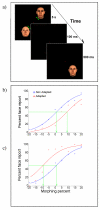Retinotopy of the face aftereffect
- PMID: 18078975
- PMCID: PMC2674370
- DOI: 10.1016/j.visres.2007.10.028
Retinotopy of the face aftereffect
Abstract
Physiological results for the size of face-specific units in inferotemporal cortex (IT) support an extraordinarily large range of possible sizes--from 2.5 degrees to 30 degrees or more. We use a behavioral test of face-specific aftereffects to measure the face analysis regions and find a coarse retinotopy consistent with receptive fields of intermediate size (10 degrees -12 degrees at 3 degrees eccentricity). In the first experiment, observers were adapted to a single face at 3 degrees from fixation. A test (a morph of the face and its anti-face) was then presented at different locations around fixation and subjects classified it as face or anti-face. The face aftereffect (FAE) was not constant at all test locations--it dropped to half its maximum value for tests 5 degrees from the adapting location. Simultaneous adaptation to both a face and its anti-face, placed at opposite locations across fixation, produced two separate regions of opposite aftereffects. However, with four stimuli, faces alternating with anti-faces equally spaced around fixation, the FAE was greatly reduced at all locations, implying a fairly coarse localization of the aftereffect. In the second experiment, observers adapted to a face and its anti-face presented either simultaneously or in alternation. Results showed that the simultaneous presentation of a face and its anti-face leads to stronger FAEs than sequential presentation, suggesting that face processing has a dynamic nature and its region of analysis is sharpened when there is more than one face in the scene. In the final experiment, a face and two anti-face flankers with different spatial offsets were presented during adaptation and the FAE was measured at the face location. Results showed that FAE at the face location was inhibited more as the distance of anti-face flankers to the face stimulus was reduced. This confirms the spatial extent of face analysis regions in a test with a fixed number of stimuli where only distance varied.
Figures








References
-
- Afraz SR, Kiani R, Esteky H. Microstimulation of inferotemporal cortex influences face categorization. Nature. 2006;442(7103):692–5. - PubMed
-
- Anderson ND, Wilson HR. The nature of synthetic face adaptation. Vision Res. 2005;45(14):1815–28. - PubMed
-
- Biederman I, Cooper EE. Evidence for complete translational and reflectional invariance in visual object priming. Perception. 1991;20(5):585–93. - PubMed
-
- Blake R, Fox R. Adaptation to invisible gratings and the site of binocular rivalry suppression. Nature. 1974;249(456):488–90. - PubMed
-
- Blanz V, Vetter T. A morphable model for the synthesis of 3D faces. In: Waggenspack W, editor. 1999 Symposium on Interactive 3D Graphics-Proceedings of SIGGRAPH’99. ACMPress; New York: 1999. pp. 187–194.
Publication types
MeSH terms
Grants and funding
LinkOut - more resources
Full Text Sources

